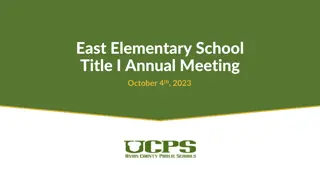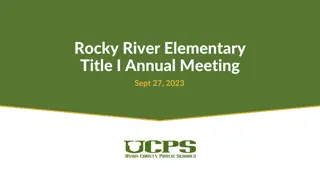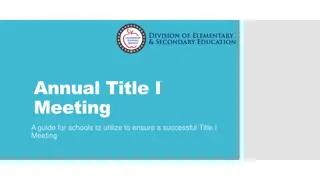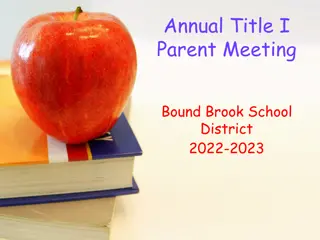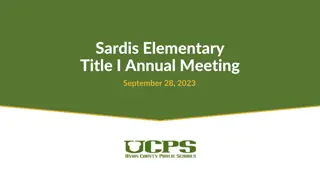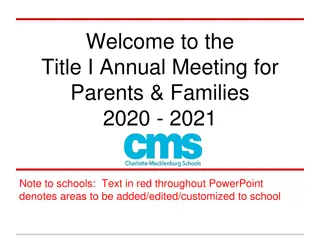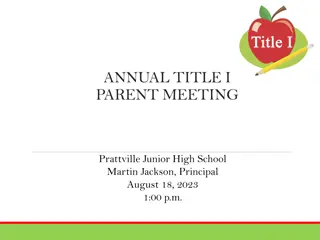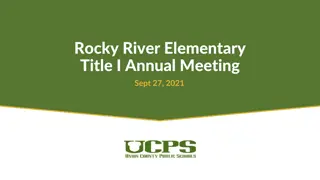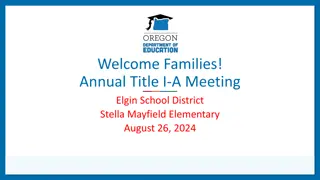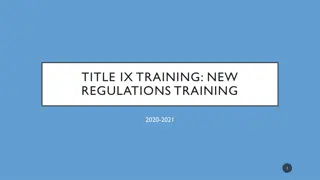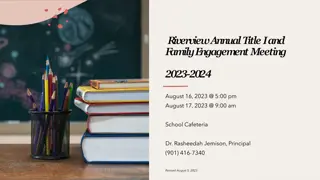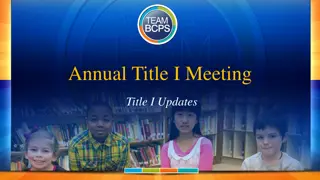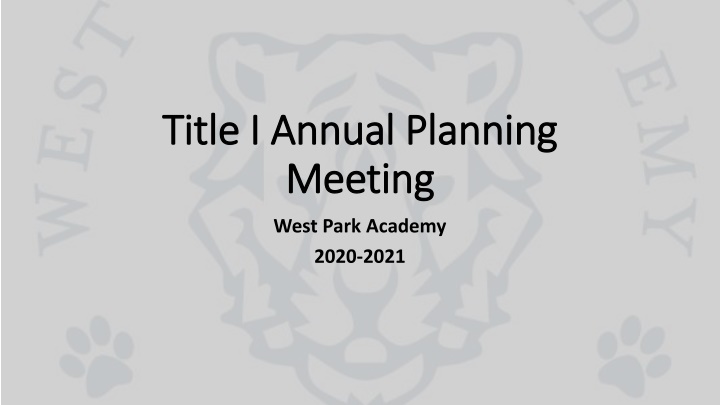
Title I Annual Planning for Equal Education Opportunity
Explore the purpose of Title I annual planning and how it ensures equal education opportunities for all children. Learn about targeted vs. schoolwide assistance programs, the use of funds, and required allocations. Discover how Title I programs support students in need, aiming for academic success and proficiency on state standards.
Download Presentation

Please find below an Image/Link to download the presentation.
The content on the website is provided AS IS for your information and personal use only. It may not be sold, licensed, or shared on other websites without obtaining consent from the author. If you encounter any issues during the download, it is possible that the publisher has removed the file from their server.
You are allowed to download the files provided on this website for personal or commercial use, subject to the condition that they are used lawfully. All files are the property of their respective owners.
The content on the website is provided AS IS for your information and personal use only. It may not be sold, licensed, or shared on other websites without obtaining consent from the author.
E N D
Presentation Transcript
Title I Annual Planning Title I Annual Planning Meeting Meeting West Park Academy 2020-2021
Purpose Purpose The purpose of Title I is to ensure that all children have a fair, equal and significant opportunity to obtain a high-quality education and at a minimum, reach proficiency on challenging state academic achievement standards and assessments. Eligible entities receive Title I funds based primarily on U.S. Census data of low-income students; however, services are provided to students identified as having the greatest need for assistance and most at risk of failing challenging state academic achievement standards.
Targeted vs schoolwide Targeted vs schoolwide Targeted assistance programs are supplemental Title I services provided to a select group of eligible children who are identified by schools (or districts) as failing or most at risk of failing to meet the state s reading and mathematics standards. Children must be ranked and served from highest to lowest risk using multiple educationally related criteria. Schools are eligible to operate Title I programs if the school s poverty is above 35 percent or the district-wide poverty average. Targeted assistance programs must offer supplemental services beyond what is offered in the required curriculum. Typical services include additional instruction or tutoring; professional development on Title I programs to administrators, teachers and parents; additional books and other supplies; additional equipment and increased parental involvement activities.
Targeted vs schoolwide Targeted vs schoolwide A Title I schoolwide program may serve all students in a school, rather than providing separate services as required under the targeted assistance program. A schoolwide program allows the school significant flexibilities, as it considers all students to be Title I-eligible students and all teachers to be Title I teachers. To be eligible to be a schoolwide program 40 percent or more of the students must be identified as low-income or the school has been identified as a Priority or Focus school. A school must complete a comprehensive one-year planning process or receive permission from the Office of Federal Programs before operating a schoolwide program. This is West Park Academy
Use of funds Use of funds Districts provide the majority of their Title I funds to eligible buildings, based on a rank order. However, there are some district- level required and allowable set-asides applied before the districts provide funding to (serve) their Title I buildings.
REQUIRED Use of funds REQUIRED Use of funds Districts in Academic Distress, Intensive and Moderate support status (or have schools with a D or F in gap closure) are required to set aside 20 percent of the district s Title I funds for requirements under ESEA flexibility (these funds must be used to support Priority, Focus or Watch schools); Districts are required to set aside 1 percent of their Title I allocation (if over $500,000) for parental involvement (95 percent of the 1 percent must go to the Title I served buildings for their use); Districts are required to set aside a minimum of 1 Per Pupil Amount to support homeless services;
REQUIRED Use of funds REQUIRED Use of funds Districts are required to provide Title I nonpublic equitable services to eligible students (number of low income nonpublic school students living in the Title I-funded attendance area in the grade levels of the Title I-funded school multiplied by the corresponding Title I served building s Per Pupil Amount.); Up to 5 percent for professional development to ensure teachers and paraprofessionals become highly qualified.
EXAMPLES OF ALLOWABLE Use of EXAMPLES OF ALLOWABLE Use of funds funds Employee salaries and benefits (must maintain appropriate time and effort distribution records if employee has duties other than Title I); Supplemental supplies, educational materials and equipment that are reasonable, necessary and specific to Title I purposes. The Ohio Department of Education recommends districts spend no more than 10 percent of their allocation on supplies and equipment (combined); Travel and conferences that are reasonable and necessary and specific to the Title I program, not the general needs of the district or school;
EXAMPLES OF ALLOWABLE Use of EXAMPLES OF ALLOWABLE Use of funds funds Maintenance/operating costs that are reasonable and necessary for the success of the Title I program and distributed on an equitable basis (i.e., janitorial and utility costs); Light refreshments for parent meetings/trainings; Indirect costs; Costs that are reasonable and necessary to accomplish the intent and purposes of the grant.
PROHIBITED Use of funds PROHIBITED Use of funds Alcoholic beverages; Entertainment, recreation and social events; Donations; Employee service awards; Fines and penalties; Food and beverages (with certain exceptions); Fundraising activities; Gifts and monetary rewards (i.e., gift cards); Lobbying; Memberships in organizations that substantially engage in lobbying; Promotional items; Professional or individual liability insurance; Regular school day transportation.
IDEA Part B Funds IDEA Part B Funds Part B of IDEA is the Federal law that provides for assistance to States and school districts in making a free appropriate public education (FAPE), which includes special education and related services, available to children with disabilities in the least restrictive environment. Letter provides information about your rights and protections under Part B of the Individuals with Disabilities Education Act (IDEA).
Parents Right to Know Teacher Qualifications Parents Right to Know Teacher Qualifications A parent or guardian may request information on the professional qualifications of each classroom teacher who provides instruction to the parent or guardian s child. The information that may be requested includes: Licensure and certification information Educational background Qualifications of Instructional Aides (if applicable)
School School- -Parent Compact Parent Compact West Park Academy, and the parents of the students participating in activities, services, and programs funded by Title I, Part A of the Elementary and Secondary Education Act (ESEA) (participating children), agree that this compact outlines how the parents, the entire school staff, and the students will share the responsibility for improved student academic achievement and the means by which the school and parents will build and develop a partnership that will help children achieve the State s high standards. This school-parent compact is in effect during school year 2020-21.
School School- -Parent Compact Parent Compact School Responsibilities: West Park Academy will: Hold parent-teacher conferences during which this compact will be discussed as it relates to the individual child s achievement. Specifically, those conferences will be held: upon request of the teacher (s), parent(s), administration, or guidance. Provide parents with frequent reports on their children s progress. Specifically, the school will provide report cards as identified by the annual school calendar. Provide parents reasonable access to staff. Specifically, staff will be available for consultation with parents as follows: during their planning period, scheduled parent/teacher conferences, through email or phone during their normal scheduled hours.
School School- -Parent Compact Parent Compact School Responsibilities: West Park Academy will: When allowable, provide parents opportunities to volunteer and participate in their child s class, and to observe classroom activities, as follows: upon appointment and 24-hour notice, must have prior approval form the principal. Providing instruction in a way that will motivate and encourage students. Providing a safe and positive atmosphere for learning. Supplying clear evaluations of student s progress to students and parents. Contacting the parents of the students in my class through notes, conferences, progress reports, or telephone calls to show an active interest in the success of my students.
School-Parent Compact Parent Responsibilities: We, as parents, will support our children s learning in the following ways: Monitoring attendance, ensuring my child arrives at school on time each day or logs in for virtual sessions, Making sure that homework is completed, Participating, as appropriate, in decisions relating to my children s education, Promoting positive use of my child s extracurricular time, Volunteer in my child s classroom, Participate, as appropriate, in decisions relating to my child s education Staying informed about my child s education and communicating with the school by promptly reading all notices from the school either received by my child or by mail and responding, as appropriate, Providing a time and place for quiet study and reading at home.
Parent involvement policy Parent involvement policy The School s Title I program is intended to foster and enhance parent- involvement in the School. The goal of the School is to involve parents in their children s learning and to form an open line of communication between school and home. This will be accomplished through several policies.
Parent involvement policy Parent involvement policy 1. Information - Parents are informed about school activities and events through access to their student s grades, report cards, and notes sent home, parent newsletters, parent/teacher conferences and informal personal and telephone conferences. 2. Annual Title I and/or Federal Programs Meeting - Parents have an opportunity to review Title I programs and provide input into the planning process during the annual Title I meeting held at the School during flexible dates and times. Additionally, parents rights and Title I requirements will be discussed. Additionally, parents should contact the School Administrator about ways to be involved at the School including the process for providing input regarding Title I planning and the parent involvement policy.
Parent involvement policy Parent involvement policy 3. Open Door Policy - Parents are invited to come to the School to observe the education of their children on any day with prior notification. (When allowable. Calls and emails welcome.) 4. Volunteer Program - All parents are invited to volunteer in the School on any given day of the week with prior notification and proof of a valid BCI and FBI background check clearance. (When allowable)
Parent involvement policy Parent involvement policy 5. Curriculum - The School provides a high-quality curriculum to enable the students to meet high standards. The School shares student progress with parents and provides an explanation of results to parents during the course of the school year. 6. Board of Directors Meetings - The Board of Directors meets numerous times throughout the year. Board meeting dates and times are posted at the School and published in the local newspaper. All parents and guardians are invited to attend Board meetings and can receive a Board meeting calendar upon request.
Parent involvement policy Parent involvement policy Complaint Procedure 1. Parents/Guardians who wish to express concerns should contact the building Administrator. 2. Classroom issues should be initially addressed with the classroom teacher through a scheduled appointment. If a meeting is scheduled to discuss the concern, persons in attendance must conduct themselves civilly. It is expected that concerns will be expressed in a professional manner. Disruptive or threatening behavior may result in an action to protect school personnel, such as reporting the incident to the police and/or prohibiting the parent or guardian from entering school property at any time.
Parent involvement policy Parent involvement policy Complaint Procedure (Continued) 3. A student or parent may file a written complaint that should be submitted to a teacher or the Administrator. 4. If the matter cannot be resolved informally by the Teacher and/or Administrator, the steps in resolving the complaint should adhere to the Governing Board s Complaint Policy and Procedures. Initially, complaints should be addressed formally or informally with the School personnel in a civil, respectful manner in order to be considered by School personnel. To file a complaint with the Administrator, the Complaint must be in writing on a form developed by the Administrator with the facts and specific outcome desired by the parent/guardian.
Parent involvement policy Parent involvement policy Complaint Procedure (Continued) 5. Complaints received directly by the Board, Sponsor or Ohio Department of Education shall be handled in accordance with the Board s Complaint Policy and Procedure. Upon resolution of the Complaint, the Administrator will issue a letter to the Complainant referred to as a Finding. The Finding will officially inform the Complainant that his or her Complaint was either Substantiated or Unsubstantiated.
Parent involvement policy Parent involvement policy Discussion What ideas do you have? Please share them with me Put into writing your ideas, thoughts, concerns. Google form will be sent following this presentation
PBIS PBIS Positive Behavior Intervention and Supports Mandatory for schools in Ohio No determined program, as defined by ODE Byrd s Nest Track attendance Dress code Positive Behavior Kindness Be Safe, Be Respectful, Be Responsible all areas of the school
Attendance Attendance Traditional and Virtual Traditional daily in school unless sick or family emergency Virtual 6.5 hours total each day Live (Synchronous) Off line (Asynchronous) Attendance Improvement Plans No Sick Policy Return to school: Parent Note (only certain symptoms) Doctor s Note
Academic Data Academic Data
Goals Goals Literacy Demographic Behavior 75% of students will improve grade level reading skills by end of 2020-21 50% of ELL students will grow by one designation on the OLEPA. Decrease the OSS and ISS rates by 10% from SY 2019-20 Focus Areas Speaking Writing Listening Reading Focus Areas PBIS Focus areas: Fluency Phonics Alternatives to Suspension Behavior Improvement Plans Behavior Intervention Specialist Sight Words Comprehension

